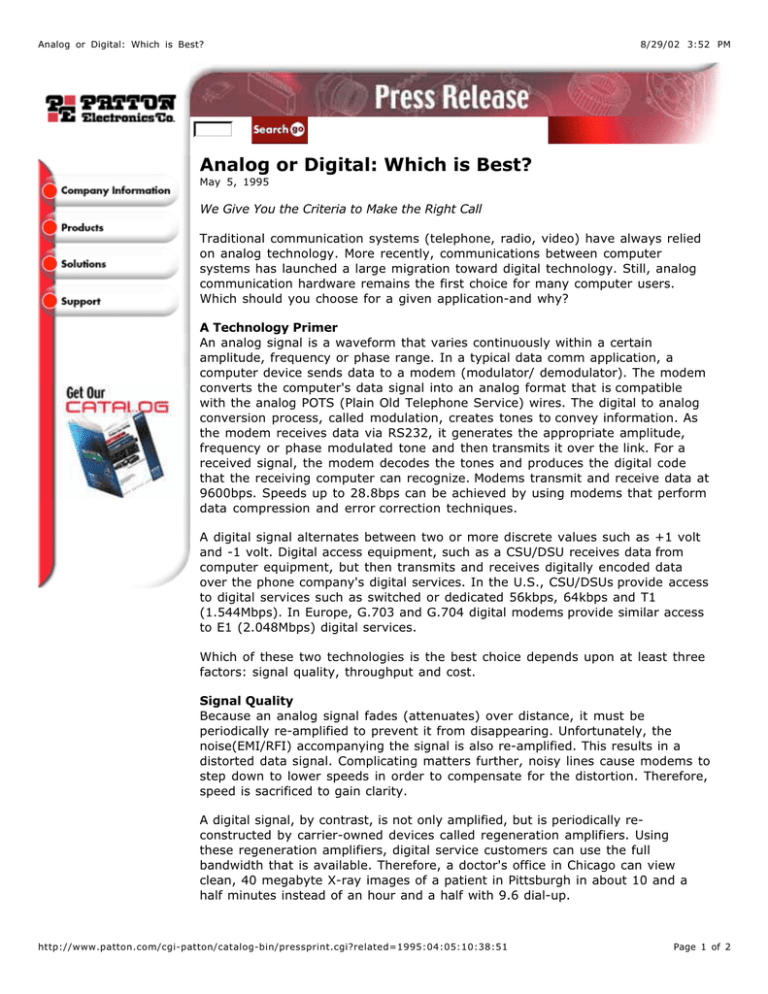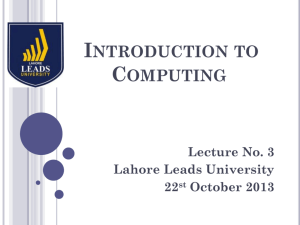
Analog or Digital: Which is Best?
8/29/02 3:52 PM
Home Contact Us Inquiry Partners
Analog or Digital: Which is Best?
May 5, 1995
We Give You the Criteria to Make the Right Call
Traditional communication systems (telephone, radio, video) have always relied
on analog technology. More recently, communications between computer
systems has launched a large migration toward digital technology. Still, analog
communication hardware remains the first choice for many computer users.
Which should you choose for a given application-and why?
A Technology Primer
An analog signal is a waveform that varies continuously within a certain
amplitude, frequency or phase range. In a typical data comm application, a
computer device sends data to a modem (modulator/ demodulator). The modem
converts the computer's data signal into an analog format that is compatible
with the analog POTS (Plain Old Telephone Service) wires. The digital to analog
conversion process, called modulation, creates tones to convey information. As
the modem receives data via RS232, it generates the appropriate amplitude,
frequency or phase modulated tone and then transmits it over the link. For a
received signal, the modem decodes the tones and produces the digital code
that the receiving computer can recognize. Modems transmit and receive data at
9600bps. Speeds up to 28.8bps can be achieved by using modems that perform
data compression and error correction techniques.
A digital signal alternates between two or more discrete values such as +1 volt
and -1 volt. Digital access equipment, such as a CSU/DSU receives data from
computer equipment, but then transmits and receives digitally encoded data
over the phone company's digital services. In the U.S., CSU/DSUs provide access
to digital services such as switched or dedicated 56kbps, 64kbps and T1
(1.544Mbps). In Europe, G.703 and G.704 digital modems provide similar access
to E1 (2.048Mbps) digital services.
Which of these two technologies is the best choice depends upon at least three
factors: signal quality, throughput and cost.
Signal Quality
Because an analog signal fades (attenuates) over distance, it must be
periodically re-amplified to prevent it from disappearing. Unfortunately, the
noise(EMI/RFI) accompanying the signal is also re-amplified. This results in a
distorted data signal. Complicating matters further, noisy lines cause modems to
step down to lower speeds in order to compensate for the distortion. Therefore,
speed is sacrificed to gain clarity.
A digital signal, by contrast, is not only amplified, but is periodically reconstructed by carrier-owned devices called regeneration amplifiers. Using
these regeneration amplifiers, digital service customers can use the full
bandwidth that is available. Therefore, a doctor's office in Chicago can view
clean, 40 megabyte X-ray images of a patient in Pittsburgh in about 10 and a
half minutes instead of an hour and a half with 9.6 dial-up.
http://www.patton.com/cgi-patton/catalog-bin/pressprint.cgi?related=1995:04:05:10:38:51
Page 1 of 2
Analog or Digital: Which is Best?
8/29/02 3:52 PM
Throughput
Analog modems can be a cost-effective solution when a small number of PCs or
workstations need to communicate with a remote server, but at 9600bps they
often create a bottleneck for large-scale, image or interactive LAN applications.
This is a significant factor when moving large amounts of data. LAN to LAN data
traffic that chugs along over non-compressed 9.6 dial-up finishes five times
faster over switched 56. A retail store that sends daily cash register receipts
from a file server in Houston to it's home office in Memphis would create a
bottle-neck if they tried to send files over 9.6 dial-up. If they used switched 56
services, they could send the same files in a fraction of the time at any time
during the day and avoid the bottleneck.
Cost
As the saying goes, "you get what you pay for". Digital services can cost more,
but sometimes the increased throughput and lower error rates justify the
expense. Often, the overall cost is less for digital service. For example, a
switched 56-kbps circuit might cost 20% more than dedicated analog leased
lines, but it provides 500% more bandwidth! With a digital access equipment, a
technology marketing company can provide email to five sales engineers rather
than just one. Tariffs may vary widely, but it normally takes two or three 9.6
circuits to justify a switched 56 circuit, and about five or six 56k circuits to justify
a T1 or E1 circuit.
Analog modem manufacturers have gone to great lengths to include
sophisticated compression and correction techniques in their modems to
compensate for the inherent impediments of analog lines. Whether these
enhancements will convince you to go with analog technology depends upon
your signal quality and throughput requirements. Your application (and budget)
will likely make the choice for you. Should you go the digital route, you will want
to consider the Patton Model 2500 Series CSU/DSU and Model 2703 G.703 Digital
Modem/Converter, both rack card and standalone.
7622 Rickenbacker Drive, Gaithersburg, MD 20879 USA
Phone: +301-975-1000 or Fax: +301-869-9293
Copyright© 2001 & 2002 Patton Electronics Co., All Rights Reserved
http://www.patton.com/cgi-patton/catalog-bin/pressprint.cgi?related=1995:04:05:10:38:51
Page 2 of 2





